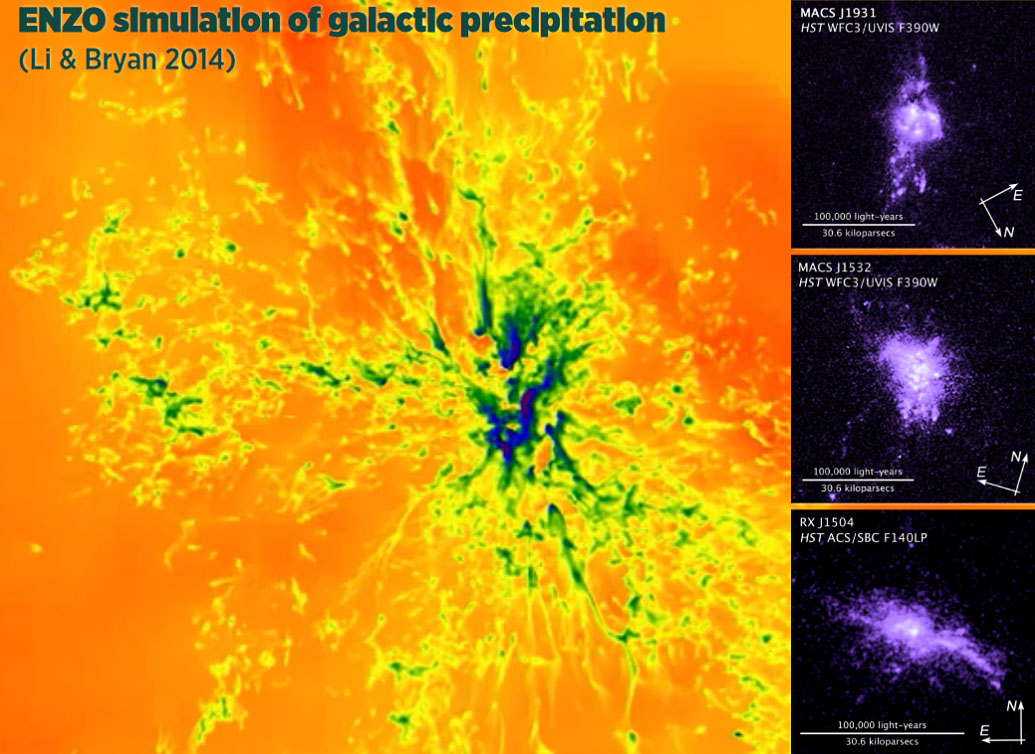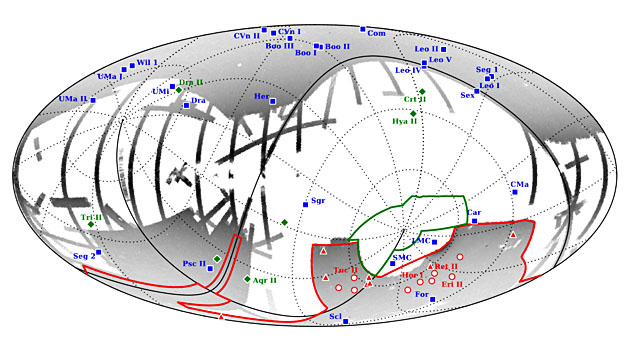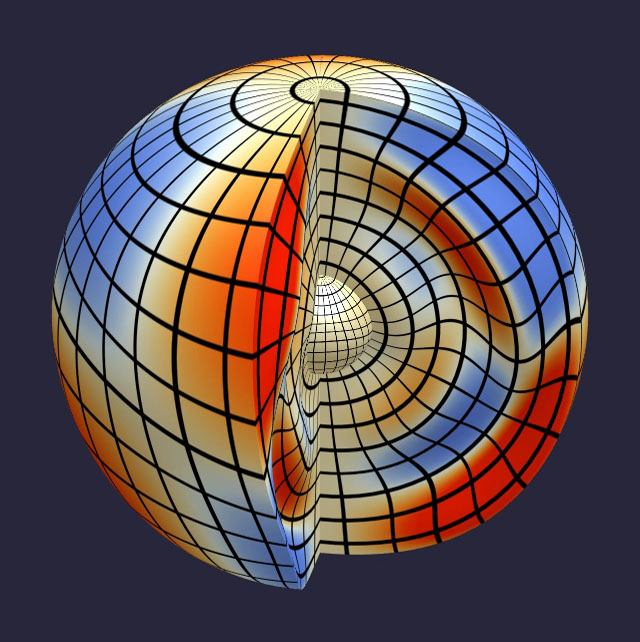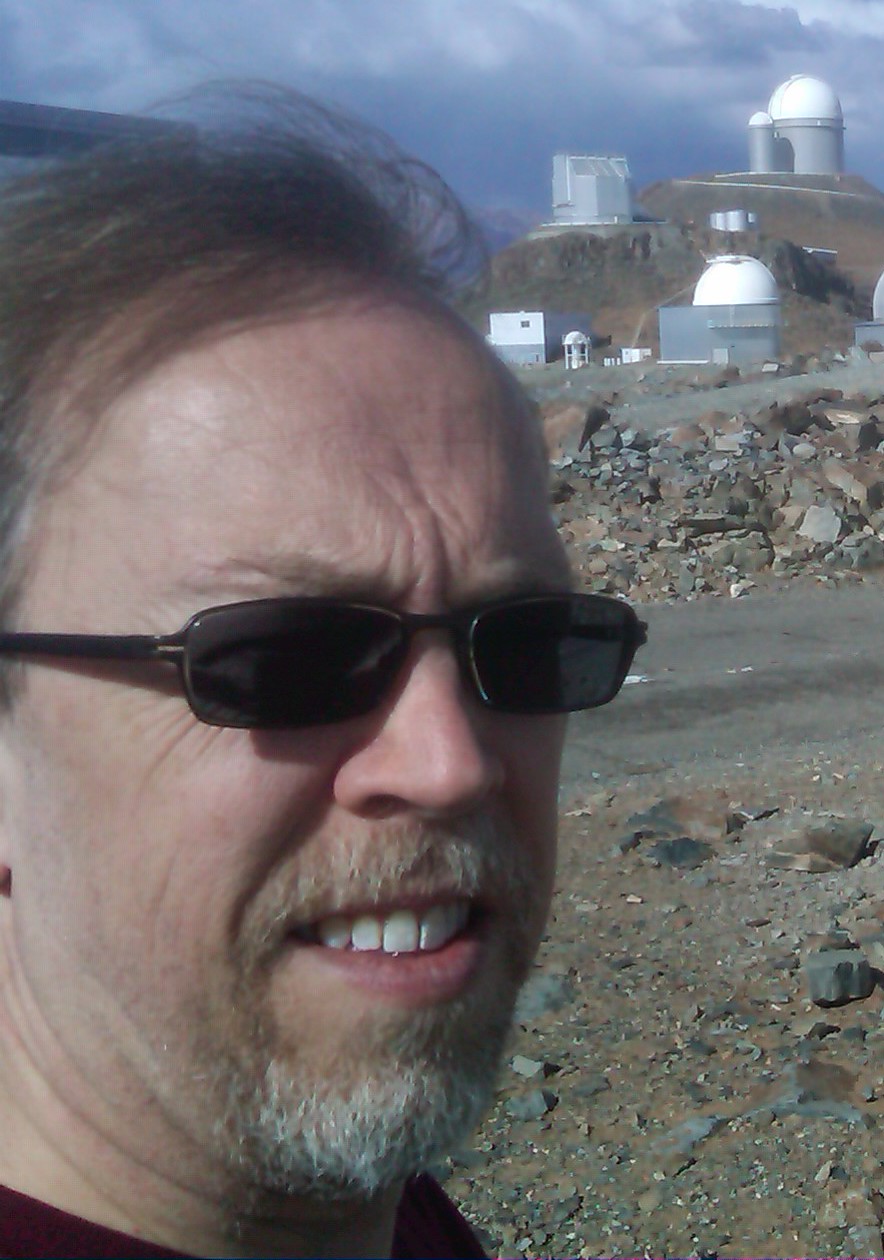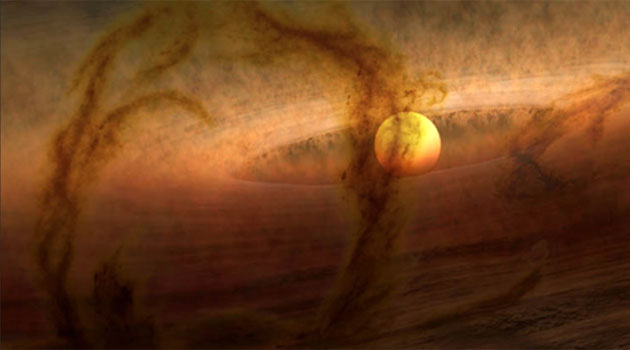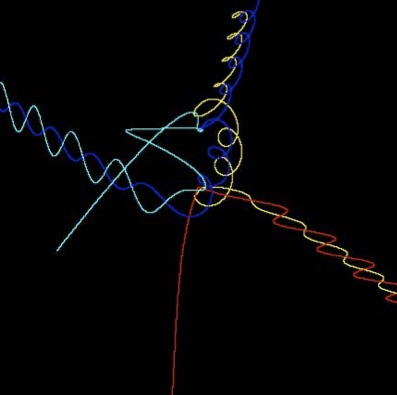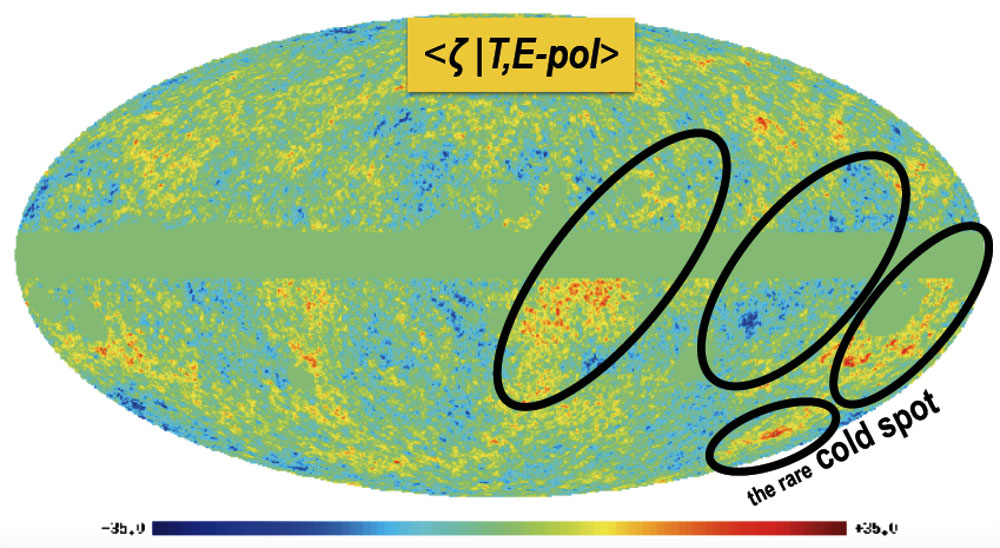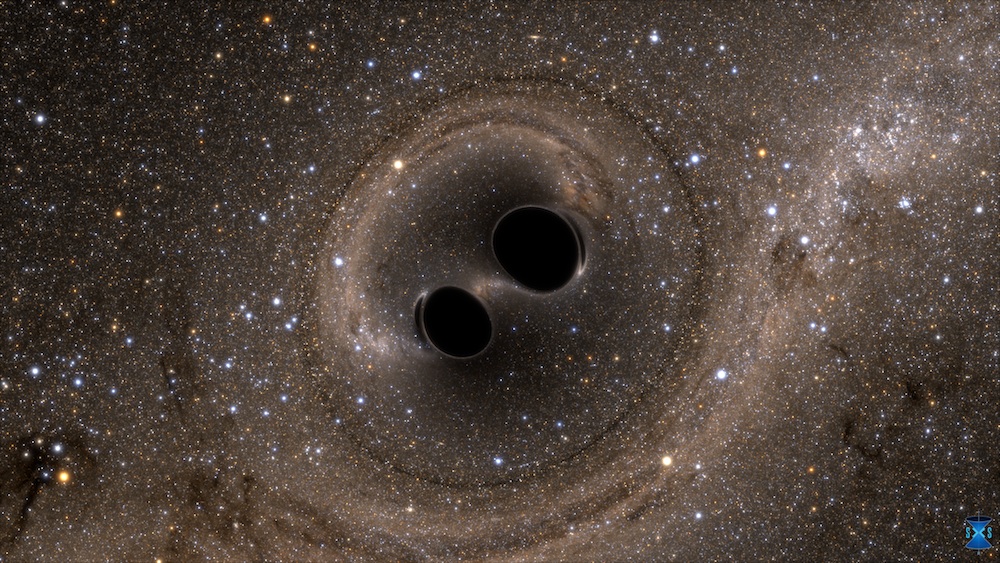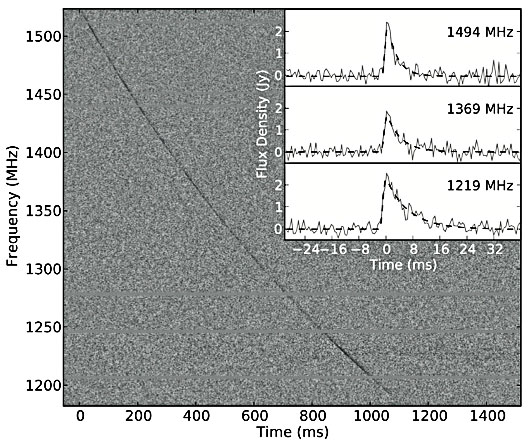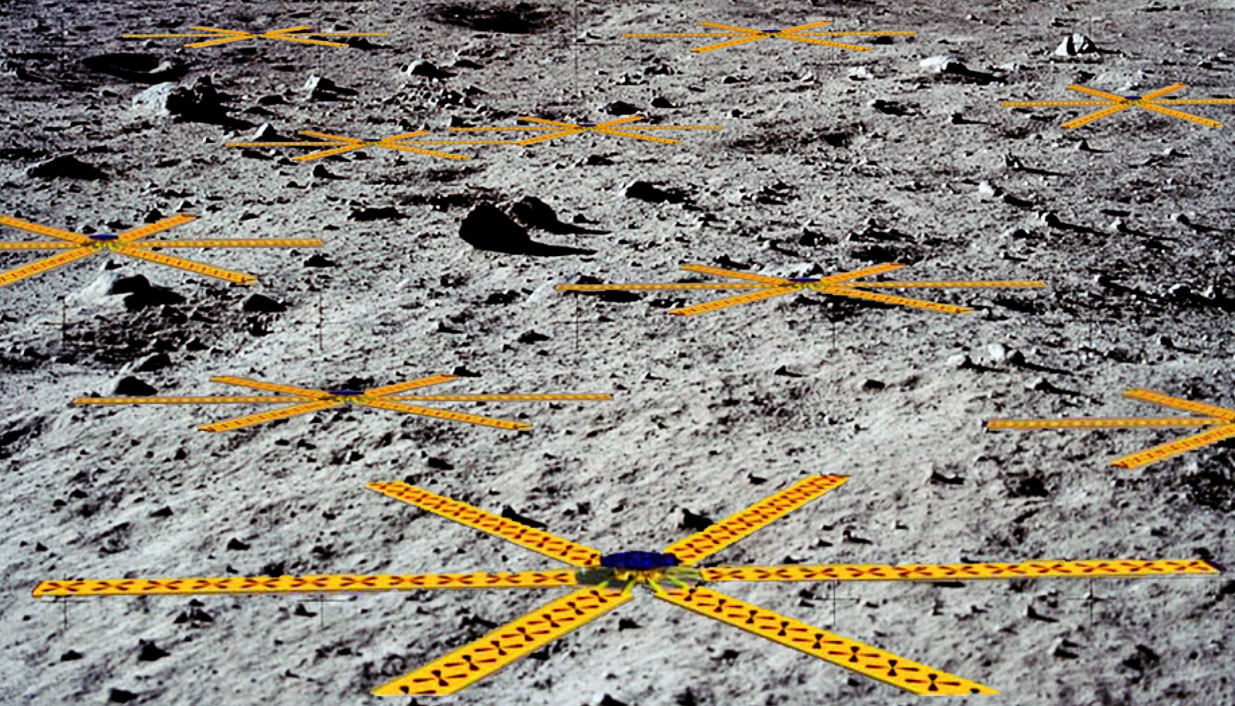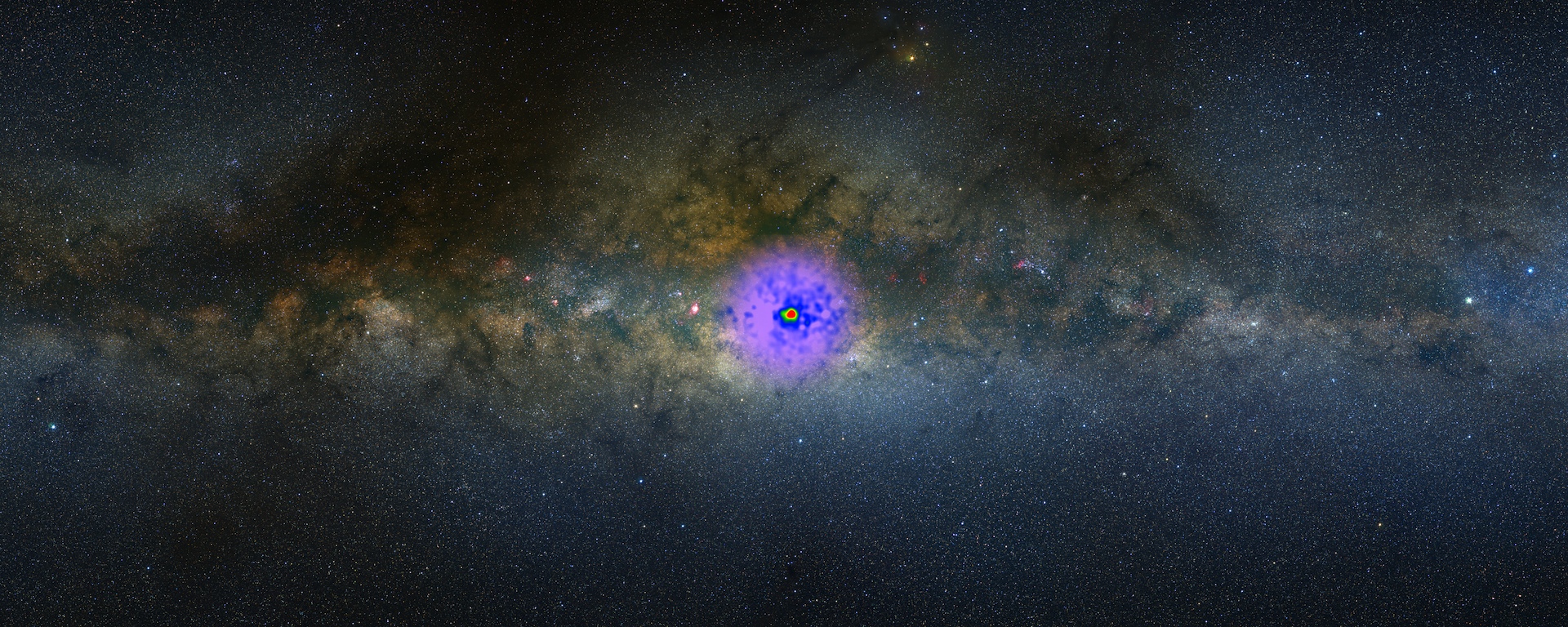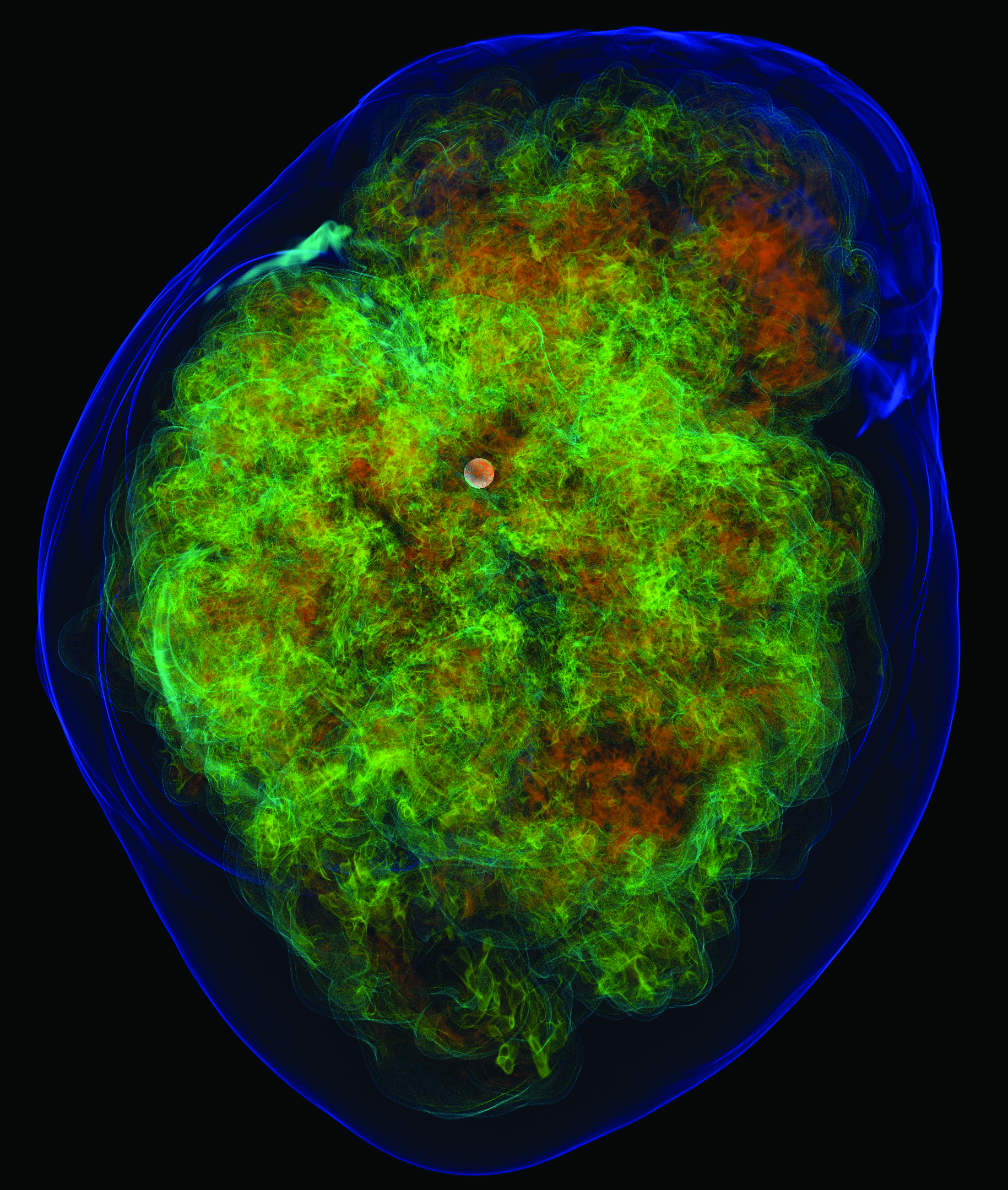 |
 |
 |
 |
 |
 |
 |
 |
 |
 |
 |
 |
|
Talks & Events
|
Colloquia: 2017
Circumgalactic Precipitation Feedback from a central supermassive black hole is an essential component of galaxy evolution models. Without it, those models cannot produce realistic massive galaxies and galaxy clusters. However, the black-hole feedback mechanism remains mysterious. Somehow, accretion of matter onto the central black hole of a massive galaxy becomes precisely tuned so that it regulates radiative cooling and condensation of gas in a volume many orders of magnitude larger than the black-hole's gravitational zone of influence. I will discuss how the required coupling can arise through condensation and precipitation of cold clouds out of a galaxy's circumgalactic medium, and will show how a feedback mechanism that suspends the circumgalactic medium in a marginally unstable state can regulate star formation within galaxies. The Milky Way's Dark Companions PDF | Video Our Milky Way galaxy is surrounded by a host of small, dark-matter-dominated satellite galaxies. Over the past two years, the Dark Energy Camera (DECam) has nearly doubled the number of known Milky Way satellite galaxies compared to the previous 80 years combined. While these discoveries continue to help resolve the "missing satellites problem", they have also raised new questions about the influence of the Magellanic Clouds on the Milky Way's satellite population. In the near future, the rapidly growing population of dwarf galaxies will be sensitive to deviations from ΛCDM at small scales, while definitively testing whether the annihilation of dark matter particles could be responsible for excess gamma-ray emission from the Galactic center. I will summarize recent results, outstanding questions, and upcoming advancements in the study of the Milky Way's dark companions. The Yin and Yang of Slowly-Pulsating B Stars: Asteroseismology and Angular Momentum Redistribution During their main-sequence evolution, almost all B-type stars will pass through a phase where they are unstable toward oscillation in one or more global internal gravity waves ('g modes'). The g modes, driven by iron and nickel opacity in the stars' outer envelopes, generate surface temperature and velocity changes with periodicities on the order of days. In the 'Yin' part of my talk, I'll discuss how time-series spectroscopy and photometry of these `slowly-pulsating B' (SPB) stars can be leveraged into asteroseismology --- probing the stars' interiors by careful analysis of their oscillation spectra. I'll highlight in particular how the Kepler mission, together with the MESA stellar evolution code and my GYRE stellar oscillation code, has allowed novel constraints to be established on the internal rotation and mixing physics of SPB stars. I'll then pivot to the 'Yang' part of my talk. Although we typically regard stellar oscillations as passive tracers of stellar structure, they can also modify this structure. I'll present recent work by my group exploring angular momentum redistribution by g modes. Modeling this process in SPB stars, we find that significant modification of internal rotation profiles can occur on timescales as short as centuries. This suggests that the g modes can impact the stars' life trajectories, a possibility that's been hitherto ignored in stellar evolution calculations. Digging into the Large Scale Structure of the Universe CANCELLED Galaxy spectroscopic surveys provide the means to map out this cosmic large-scale structure in three dimensions, furnishing a cornerstone of observational cosmology. The information is given in the form of galaxy locations, and is typically condensed into a single function of scale, such as the galaxy correlation function or power-spectrum. However, galaxy correlation functions are not the only information those surveys provide. One of the most striking features of N-body simulations is the network of filaments into which dark matter particles arrange themselves. We however traditionally only use the information contained in the positions of the galaxies, and in some occasions, we look at other cosmic structures of the Universe such as voids. In this colloquium, I explore the information beyond the galaxy positions in large sky surveys combining novel ideas with recent techniques in statistical methods and machine learning algorithms. In particular, we will investigate the following two topics: the ''cosmic web'' that are mostly ignored in any large scale structure analyses in the Universe and how it affects the surrounding galaxies; and explores the additional information beyond the typical 2 point statistics by using novel statistical and machine learning techniques. Why interstellar grain align and why you should care More than 70 years after the discovery of interstellar polarization, we now have a quantitative, empirically tested, theory of grain alignment giving ride to the observed effect. This Radiative Alignment Torque (RAT) theory predicts that dust grains are spun up by an anisotropic radiation field, if the wavelength of the light is less than the grain diameter. If the grain is made of a paramagnetic material, it will then align with the magnetic field. A number of specific, observationally testable, predictions follow from the theory, many of which have already been addressed. With a full testing of the theory and quantification of its parameters, polarimetry has the promise to not only allow efficient and reliable tracing of interstellar and interplanetary magnetic fields, but also to provide new and unique probes of the dust and the interstellar environment. I will review RAT alignment and its observational testing, and discuss some of the probes of ISM environmental parameters and dust that the verified theory allows. Space astrometry: the Hipparcos and Gaia missions Alone amongst the space agencies, ESA made its entry into space astrometry with the adoption of the Hipparcos mission in 1981. Outside of the astrometric community, it was viewed at the time as fundamental if not particularly exciting, although Freeman Dyson described it as "... the first time since Sputnik in 1957 that a major new development in space science has come from outside the US". In his ASP Millennium Essay in 2001, Cavendish Professor Malcolm Longair stated that "It is invidious to single out surveys which I find particularly impressive, but I make an exception for the Hipparcos astrometric satellite". Hipparcos delivered its high-accuracy catalogue of 120,000 star distances and space motions in 1997. As a follow-up, ESA accepted the Gaia mission in 2000. Launched in 2013 and expected to operate into the next decade, Gaia will represent a revolution in its dynamical stereoscopic mapping of our Galaxy, promising a catalogue of more than a billion stars to 20 magnitude at microarcsec-level accuracy. The talk will provide a short historical context and describe the scientific motivation for these missions, outline the essential experimental principles which underpin their measurements, and give an overview of the science objectives, including Gaia's expected yield of many thousands of astrometrically-detected exoplanets. The Speaker: Michael Perryman obtained his PhD in 1980 (Cambridge, UK) and spent most of his subsequent career with the European Space Agency. He was project scientist for Hipparcos from adoption in 1981 to catalogue finalisation in 1997, holding the dual role of overall project manager (1989-1993) after the satellite failed to achieve its nominal geostationary orbit. With Lennart Lindegren (Lund, Sweden) he was the co-originator of Gaia, and responsible for driving many of its principal attributes. He was study scientist from the Gaia's origins in 1995 to mission adoption in 2000, and thereafter ESA project scientist until the Critical Design Review in 2008. Digging into the Large Scale Structure of the Universe CANCELLED Galaxy spectroscopic surveys provide the means to map out this cosmic large-scale structure in three dimensions, furnishing a cornerstone of observational cosmology. The information is given in the form of galaxy locations, and is typically condensed into a single function of scale, such as the galaxy correlation function or power-spectrum. However, galaxy correlation functions are not the only information those surveys provide. One of the most striking features of N-body simulations is the network of filaments into which dark matter particles arrange themselves. We however traditionally only use the information contained in the positions of the galaxies, and in some occasions, we look at other cosmic structures of the Universe such as voids. In this colloquium, I explore the information beyond the galaxy positions in large sky surveys combining novel ideas with recent techniques in statistical methods and machine learning algorithms. In particular, we will investigate the following two topics: the ''cosmic web'' that are mostly ignored in any large scale structure analyses in the Universe and how it affects the surrounding galaxies; and explores the additional information beyond the typical 2 point statistics by using novel statistical and machine learning techniques. Young Star Fundamentals and Surprises Young stars associated with regions of recent star formation are both predictably, and enigmatically, variable over much of the electromagnetic spectrum -- due to processes occurring on the stellar surface, within the disk-to-star accretion zone, in the inner circumstellar disk regions, and perhaps in the outflow. The talk will begin with an overview of the relevant young star phenomena, then proceed to discuss recent work on fundamental stellar parameters for young stars, including several young planet discoveries, and then to the revelations of circumstellar phenomena based on state-of-the-art time domain data sets. How Black Holes get their Kicks: Dynamical Evolution and Coalescence Recent observations have increased interest in the possibilities of a significant population of black hole binaries in the local universe. Natal kicks may play a crucial role in the merger rate of stellar mass black holes. Dynamical evolution can lead to an enhanced interaction rate for compact binaries in dense stellar systems and a distinct and richer population of compact binaries. I discuss some of the issues related to black hole binary formation and coalescence, the issue of retention in globular clusters and possible contribution to the LIGO rate. News from PICO and COHERENT Video I will discuss the most recent results from PICO, a search for WIMP dark matter using bubble chambers, as well as future plans and some exciting lines of related research. I will then move on to cover COHERENT, an ongoing effort at ORNL's Spallation Neutron Source to detect and exploit coherent neutrino-nucleus scattering, soon to produce first results. The "glue" between these two subjects will be an elaboration on the overlap in techniques and methods used in modern neutrino and astroparticle physics. Abundant examples of this cross-talk will be provided. Probing Chemical Enrichment in the Circumgalactic Medium -- Combining Absorption Spectroscopy and Direct Imaging Observations Tremendous progress has been made over the last decade in our empiricaland theoretical understanding of how galaxies form and evolve across cosmic time. In particular, state-of-the-art cosmological simulations can not only match the large-scale statistical properties of galaxies, but they can also successfully reproduce the observed small-scale features of star-forming disks. However, these models have fallen short in matching the empirical properties of diffuse gas, which constitutes 90% of all baryons in the universe, beyond visible galaxy disks and into circumgalactic space. An accurate characterization of the complex physical processes that govern the interactions between star-forming regions and this diffuse circumgalactic medium (CGM) is a critical next step toward a comprehensive understanding of galaxy formation and evolution. In this talk, I will summarize the progress and challenges in CGM studies from traditional absorption-line observations, and discuss future prospects in direct imaging of the CGM around distant galaxies. Observing, Mapping and Mocking our Cosmic Beginnings Video I will give my take on the phenomenology (and yes theory) of inflation as revealed in Planck and other CMB) and LSS experiments, but with an eye to the glorious CMB future of AdvACT, CCAT-p, Simons Observatory, Stage 4, and the LSS of Euclid, Chime, and much more besides that we mock. Apart from displaying linear and quadratic maps of the primordial universe, a compression of what we now know, i will chat about CMB/LSS anomalies, in practice and in theory, pointing to post-inflation chaotic dynamical systems that can lead to subdominant non-Gaussian signals unlike the ones we have put such stringent constraints on with Planck 2015; and relate everything to non-equilibrium entropies, including the formation of all cosmic structure. First results from LIGO: past, present and future The Laser Interferometer Gravitational-wave Observatory (LIGO) detected gravitational waves for the first time in 2015. Since then there have been a couple more detections of binary black hole mergers. I will discuss the instruments that made these discoveries, the science so far, and plans for future improvements and upgrades to LIGO. Novel detectors for next-generation mm-wavelength instruments The kinetic inductance detector (KID) is a novel superconducting photon detector. It offers simple fabrication, intrinsic multiplexing of thousands of detectors per cable, and much higher dynamic range than competing technologies, and has now demonstrated background limited operation suitable for ground-based instruments at mm and submm wavelengths. I'll discuss two specific applications that make use of these new devices. The first, SuperSpec, is an compact on-chip, mm-wavelength spectrometer. Its small size, wide spectral bandwidth, and highly multiplexed detector readout will enable construction of powerful multi-object spectrometers able to catalog thousands of dusty star forming galaxies at high redshift. I will discuss the design, optimization, and measured performance of our prototype devices, our upcoming engineering run with the SuperSpec demonstration camera, and the unique observational opportunities accessible to future large-scale facility instruments based upon this technology. The second project, the Chicago CMB-KIDs program, is developing a KID-based, polarization sensitive, multi-band focal plane array optimized for CMB observations. I'll discuss our pixel designs and progress toward producing laboratory demonstration of a full-scale array suitable for deployment in a future CMB instrument. Dust polarization and interstellar turbulence Perhaps the most surprising result from the Planck satellite is the observation that the E-mode power in the dust polarization is twice that in the B mode. In this talk I will show how the E and B modes in the dust polarization are related to fluctuations in the magnetized interstellar medium. I will argue that the observed E/B ratio, as well as the TE (temperature-polarization) cross-correlation are not easily reconciled with expectations from MHD turbulence. I will then discuss some alternative explanations for the dust-emission patterns seen in the Planck temperature-polarization maps and outline some interesting directions for future related research. Fast Radio Bursts! Video On a human scale most astronomical sources are large and vary slowly. They must be large enough to produce enough light be to seen at astronomical distances and the light travel time across a large source limits the timescale for observable variations. Nevertheless in recent years extremely rapidly varying radio emission has been detected and found to be a common phenomena. The most extreme case has timescales as small as one nanosecond, inferred size smaller than one meter, peak luminosity exceeding that of the Sun, and is observed at a distance of 2kpc. More numerous and further away are Fast Radio Bursts (FRBs), originating at cosmological distances, lasting a millisecond and arriving at Earth a few times a minute. These events are the brightest sources known in terms of an off-scale brightness temperature, yet the emission mechanism is undetermined. I will discuss some ideas for the origin of this emission and how these bright bursts could be used to augment gravitational wave and neutrino astronomy as well as the study of cosmological parameters and the intergalactic medium. Automated Object Classification for Large Scale Future Surveys: A Strong Lensing Example with Machine Learning Video Gravitational lensing offers a direct probe of the underlying mass distribution of lensing systems, a window to the high redshift universe, and a geometric probe of cosmological models. The advent of large scale surveys such as the Large Synoptic Sky Telescope and Euclid has prompted a need for automatic and efficient identification of strong lensing systems. We present (1) (ALL) Automated Lensing Learner, a strong lensing identification pipeline that will be publicly released as open source software, and (2) a publicly available mock LSST dataset with strong galaxy-galaxy lenses. In this first application of the pipeline, we employ a fast feature extraction method, Histogram of Oriented Gradients (HOG), to capture edge patterns that are characteristic of strong gravitational arcs in galaxy-galaxy lensing. We use logistic regression to train a supervised classifier model on the HOG of HST- and LSST-like images. Our tests demonstrate an efficient and effective method for automatically identifying strong lenses that captures much of the complexity of the arc finding problem. The linear classifier both runs on a personal laptop and can easily scale to large data sets on a computing cluster, all while using existing open source tools. Mapping the Cosmos with the Dark Energy Survey - sneak peek of the first year weak lensing results Video Weak gravitational lensing, or weak lensing, is one of the most powerful tools in cosmology. The technique relies on measuring accurately the shape of a large number of galaxies, and statistically translating the shape measurements into (dark matter) mass distributions. The first year data from the Dark Energy Survey (DES Y1) provides the most powerful weak lensing dataset to date. In this talk I will first give an update on the status of the cosmology analysis from DES Y1 data and present some preliminary results. Next, I will describe our work in generating and testing the wide-field weak lensing mass maps from the galaxy shape measurements and some exciting applications for the maps. I will end with thoughts on how weak lensing could also inform us on various topics of galaxy formation, which is essential for completing the story behind the Universe we see today. First observation of coherent elastic neutrino-nucleus scattering Video The process of coherent elastic neutrino-nucleus scattering (CEvNS) was predicted in 1974 by D.Z. Freedman, who suggested that attempts to detect CEvNS “may be an act of hubris†due to several profound experimental challenges. More than 40 years after its initial description, the world’s smallest functional neutrino detector has been used by the COHERENT Collaboration to produce the first observation of the process: a 14.6-kg CsI[Na] scintillator was deployed to the Spallation Neutron Source of Oak Ridge National Lab and observed, with high significance, evidence for a CEvNS process in agreement with the prediction of the Standard Model. I will discuss CEvNS and its connection to a range of exciting physics, including: its potential role in supernova dynamics; the possibility to use neutrinos as a tool for studying nuclear structure and neutron stars; its relationship to upcoming direct searches for WIMP dark matter; and the ways in which CEvNS could offer insight into physics beyond the Standard Model. The experimental program and the recent result from the COHERENT Collaboration will be presented along with ongoing efforts within the collaboration and future plans. AGN-driven outflows at z~2 AGN-driven outflows are assumed to be a key driver of galaxy evolution, determining the shape of the galaxy stellar mass function at high masses and regulating, perhaps even quenching, star formation as galaxies become quiescent. However, the details of how common this feedback is and how it impacts the host galaxy are generally unclear. I will present new results using Chandra data in the CANDELS and UltraVISTA surveys showing which galaxies host AGN of a given accretion rate and how this correlates with star formation in the host galaxy from z~0 to z~4. I will further present new results from the MOSDEF survey on AGN-driven outflows at z~2, discussing their incidence, kinematics, and physical extent. We find that fast, galaxy-wide AGN-driven outflows are common in typical star-forming galaxies at z~2 and that they likely help regulate star formation at the cosmic peak of galaxy growth. The Limits of Cosmology Video One of our greatest challenges in cosmology is understanding the origin of the structure of the universe, and in particular the formation of the galaxies. I will describe how the fossil radiation from the beginning of the universe, the cosmic microwave background, has provided a window for probing the initial conditions from which structure evolved and seeded the formation of the galaxies, and the outstanding issues that remain to be resolved. I will address our optimal choice of future strategy in order to make further progress on understanding our cosmic origins. Imaging All the Sky All the Time in Search of Radio Exoplanets All the magnetized planets in our solar system, including Earth, produce bright emission at low radio frequencies, predominantly originating in high magnetic latitudes and powered by auroral processes. It has long been speculated that similar radio emission may be detectable from exoplanets orbiting nearby stars, which would provide the first direct confirmation of the presence, strength and extent of exoplanetary magnetospheres, as well as informing on their role in shielding the atmospheres of potentially habitable exoplanets. Despite 4 decades of observations, no detection has been achieved. Surprisingly, however, brown dwarfs have been found to produce both radio and optical emissions that are strikingly similar to the auroral emissions from solar system planets, albeit 10,000 times more luminous, bolstering the continued search for similar emission from exoplanets. I will discuss the auroral radio emission from exoplanets and brown dwarfs and introduce a new radio telescope, consisting of 352 antennas spaced across 2.5 km, that images the entire viewable sky every ten seconds at low radio frequencies, thereby monitoring thousands of stellar systems simultaneously in the search for radio emission from exoplanets. Probing Cosmology with the Dark Energy Survey Video I will overview the Dark Energy Survey (DES) project and highlight its early science results, focusing on the recently released cosmology results from the first year of the survey. The DES collaboration built the 570-megapixel Dark Energy Camera for the Blanco 4-meter telescope at NOAO's Cerro Tololo Inter-American Observatory in Chile to carry out a deep, wide-area, multi-band optical survey of several hundred million galaxies and a time-domain survey to discover several thousand supernovae. The survey started in Aug. 2013 and is now in its fifth observing season. DES was designed to address the questions: why is the expansion of the Universe speeding up? Is cosmic acceleration due to dark energy or does it require a modification of General Relativity? DES is addressing these questions by measuring the history of cosmic expansion and the growth of structure through multiple complementary techniques: galaxy clusters, the large-scale galaxy distribution, gravitational lensing, and supernovae, as well as through cross-correlation with other data sets. I will also discuss how the DES data are being used to make a variety of other astronomical discoveries, from the outer Solar System to ultra-faint dwarf galaxies to the kilonova counterpart of a binary neutron star gravitational-wave source. The WIMP is dead. Long live the WIMP! Although weakly interacting massive particles (WIMPs) have long been the leading class of candidates for the dark matter of our universe, the lack of a confirmed detection of these particles has left the community increasingly skeptical of their existence. In this talk, I will ask the following questions: How surprised should we be that WIMPs have not yet been detected? What assumptions might we change in order to explain the lack of any clear signals of dark matter? In light of the current experimental situation, what are the prospects for future direct, indirect and collider searches for dark matter? And lastly, may we already be observing evidence of annihilating WIMPs in the gamma-ray sky? Journey to the Beginning of Time: Turning Metaphysics into Physics Video Even a generation ago, fundamental existential questions such as, "How did the Universe Begin?, How will it End?, Are we Alone, and, Are there OTHER Universes?," and other less grand but no less interesting questions such as "Do Black Holes Exist?" may have appeared as forever inaccessible metaphysical questions. Gravitational waves have now been discovered by LIGO, opening up a vast new window on the Universe. I will explain how we might eventually unambiguously detect a gravitational signal from moments after the Big Bang, pushing our direct empirical handle on the Universe back in time by 49 orders of magnitude, and revealing what we might learn about own origins, the nature of gravity, grand unification, and even the possible existence of other universes. Pulsar Magnetosphere: The Incredible Machine Pulsars are rotating magnetized neutron stars that emit repeating pulses of radiation spanning all of the electromagnetic spectrum. 50 years after their discovery, more than 2000 pulsars are known, and they have been used as sensitive astronomical probes of diverse phenomena ranging from the properties of interstellar medium to the predictions of general theory of relativity. Despite great observational successes, our theoretical understanding of how pulsar magnetospheres work is woefully incomplete. Pulsars bring together aspects of classical and quantum electrodynamics, coupled with strongly magnetized plasma physics in curved rotating spacetime of a massive compact object. The nonlinear interplay of these effects makes it a very difficult but rewarding problem to study. I will review the status and progress of pulsar magnetospheric modeling in various approximations, including force-free and relativistic magnetohydrodynamics, culminating with recent developments of fully kinetic simulations of pulsar magnetospheres. These simulations allow us to find the shape of the magnetosphere and the location of particle acceleration regions, constraining the origin of high energy emission. The pulsar magnetosphere is a prototype for other strongly magnetized astrophysical objects, and I will discuss how the lessons from pulsar modeling can be useful in understanding the physics of black hole disks and in predicting electromagnetic counterparts to gravitational wave sources. Core-Collapse Supernova Explosion Physics Core-collapse supernovae have challenged theorists and computational science for more than half a century. Such explosions are the source of many of the heavy elements in the Universe and the birthplace of neutron stars and stellar-mass black holes. However, determining the mechanism of explosion remains the key goal of theory. Recently, there have been breakthroughs in understanding and simulating these explosions, and I will describe our recent calculations that lead to robust explosions and the physics behind them. All these events have gravitational-wave and neutrino signatures that could be diagnostic of the internal dynamics of the mechanism and explosion phenomenology in real time. I will discuss such signatures and how their detection might bear on a definitive experimental resolution of the core-collapse puzzle. The not so boring ultra-high energy cosmic ray sky Video After more than 12 years of continuous data taking, the Pierre Auger Observatory has collected the largest dataset of ultra-high energy cosmic rays (UHECR) to date. It combines a set of fluorescence telescopes to measure the tiny emission of light from air molecules excited by the passage of air showers and an array of ground based water Cherenkov tanks to sample the shower particles at the ground level, Such a hybrid detection system has allowed a redundancy in reconstruction variables as well as the elimination of large systematic uncertainties associated to the absolute energy scale of atmospheric cascades through a data-driven cross-calibration procedure between the two detectors. The results obtained in the last years include, for example, precise and accurate measurements of the UHECR flux across a few decades in energy, revealing distinctive spectral features that can bring valuable information on different astrophysical processes like: the transition from galactic to extragalactic fluxes; the different energy loss processes to which ultra-relativistic charged particles are subject during their propagation; the energetics of the production and acceleration of particles at the candidate sources. In this colloquium I should however focus on a particular observational probe, that is, the small levels of anisotropy in the flux of UHECR at different angular scales: from the small and intermediate ones, important for the identification of possible point sources, to the large angular scales, usually used to search for signs of the galactic to extragalactic transition. In particular, special attention will be devoted to the first observation of a large scale anisotropy signal at the highest energies recently reported by the collaboration. |

